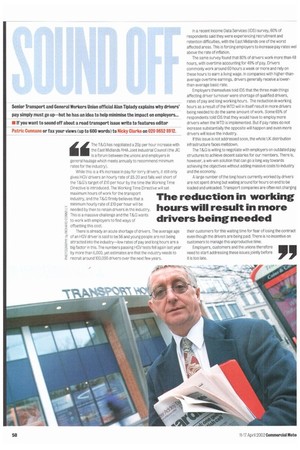Senior Transport and General Workers Union official Alan Tiplady explains
Page 50

If you've noticed an error in this article please click here to report it so we can fix it.
why drivers' pay simply must go up—but he has an idea to help minimise the impact on employers...
• If you want to sound off about a road transport issue write to features editor Patric Cunnaue or fax your views (up to 600 words) to May Clarke on 020 8652 8912.
ii The T&G has negotiated a 20p per hour increase with
the East Midlands RHA Joint Industrial Council (the JIC is a forum between the unions and employers in general haulage which meets annually to recommend minimum rates for the industry).
While this is a 4% increase in pay for lorry drivers, it still only gives HGV drivers an hourly rate of L5.20 and falls well short of the T&G's target of E10 per hour by the time the Working Time Directive is introduced. The Working Time Directive will set maximum hours of work for the transport industry, and the T&G firmly believes that a minimum hourly rate of £10 per hour will be
it needed by then to retain drivers in the industry, .f.i. This is a massive challenge and the T&G wants to work with employers to find ways of
rc ‹ offsetting this cost. x g There is already an acute shortage of drivers. The average age
5 of an HGV driver is said to be 56 and young people are not being tr attracted into the industry—low rates of pay and long hours are a 5 big factor in this. The numbers passing HGV tests fell again last year 12 by more than 6,000, yet estimates are that the industry needs to E recruit around 100,000 drivers over the next few years.
In a recent Income Data Services (IDS) survey, 60% Of respondents said they were experiencing recruitment and retention difficulties, with the East Midlands one of the worst affected areas. This is forcing employers to increase pay rates wel above the rate of inflation.
The same survey found that 80% of drivers work more than 48 hours, with overtime accounting for 49% of pay. Drivers commonly work around 60 hours a week or more and rely on these hours to earn a living wage. In companies with higher-thanaverage overtime earnings, drivers generally receive a lowerthan-average basic rate.
Employers themselves told IDS that the three main things affecting driver turnover were shortage of qualified drivers, rates of pay and long working hours. The reduction in working hours as a result of the WTD will in itself result in more drivers being needed to do the same amount of work. Some 65% of respondents told IDS that they would have to employ more drivers when the WTD is implemented. But if pay rates do not increase substantially the opposite will happen and even more drivers will leave the industry.
If this issue is not addressed soon, the whole UK distribution infrastructure faces meltdown, The T&G is willing to negotiate with employers on outdated pay structures to achieve decent salaries for our members. There is, however, a win-win solution that can go a long way towards achieving the objectives without adding massive costs to industry and the economy.
A large number of the long hours currently worked by drivers are not spent driving but waiting around for hours on end to be loaded and unloaded. Transport companies are often not charging their customers for this waiting time for fear of losing the contract even though the drivers are being paid. There is no incentive on customers to manage this unproductive time.
Employers, customers and the unions therefore need to start addressing these issues jointly before it is too late.






















































































































































